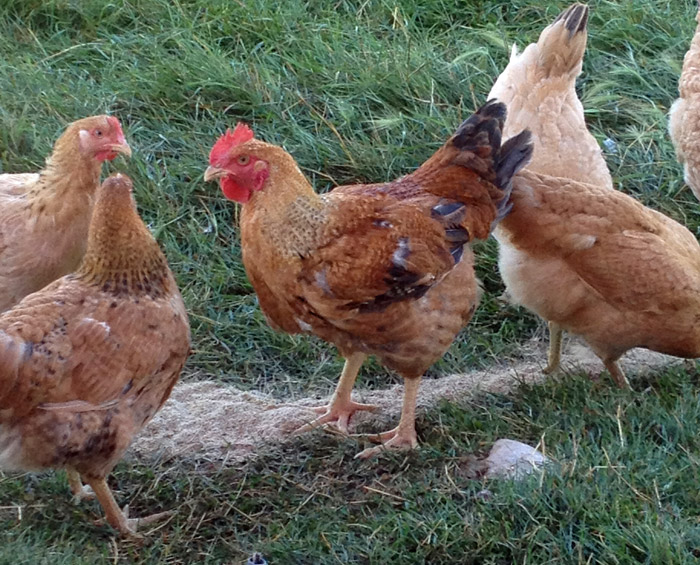Reasons abound to keep backyard chickens – it might be for fun, food security, tick control or producing fresh eggs or meat on a budget. My husband and I have been raising meat birds and keeping laying hens for years, and I can’t imagine having my families’ eggs supplied another way. If you’ve never done it, making the leap may seem intimidating. The good news is you don’t have to be an experienced farmer to keep a few chickens. As long as you understand the basics, have the ability to offer the chickens adequate feed, safe, ventilated housing, and are willing to put in the effort, you can learn as you go, and it can be a rewarding learning experience to take on as a family.
Before you start, ensure you live in an area where you can keep poultry and your neighbours are on board with you doing it. You may want to check with your municipality and/or talk to neighbours that live close-by.
Choosing your chickens
Do you primarily want to keep chickens for eggs or meat? That is the first question you need to answer, and you can narrow your search from there. Research breeds to find out pros and cons of each. Heritage breeds tend to be better foragers and more resistant to disease, but their production (of eggs or meat) won’t be as high as modern breeds. Egg layers can be purchased from neighbouring farmers, or even on Kijiji, but if you’re raising meat chickens, you’ll have to buy the chicks from a hatchery or dealer and raise them from day one. Check out local feed stores, as they often bring in chicks from local hatcheries. (Fehrway Feeds in Ridgeville or Horizon Livestock in Steinbach are two options.) Starting chicks is probably the most challenging part of keeping backyard chickens and I will discuss how to start them next month in Introduction to Keeping Backyard Chickens – Part 2.
Housing
Summer can be a good time to try out keeping poultry because housing requirements may be more manageable. First off, the chickens need shade and a location that can be secure from predators. Meat chickens require quite a well-ventilated place during the summer as they generally don’t handle heat very well. Laying hens will need comfortable laying boxes with clean straw or shavings where they can lay eggs.
Some predators are quite small and can squeeze through small openings. Overhead protection from birds might also be a consideration. At one point, my eggs were mysteriously disappearing, and we had to observe the chicken pen all day to discover a raven was raiding the laying boxes to steal the eggs.
I enjoy allowing my chickens to forage and roam free around the yard but again, but if you do this, make sure to keep them in a safe enclosed area and count them every night. (You won’t see much more than a little pile of feathers if one of them was nabbed.) And you may need to change up the routine, so the predator doesn’t make your chickens a regular source of food. You’ll also have to keep a close eye on the garden. I generally let them forage around the yard only until my garden starts coming up in May.
If you keep chickens over the winter, you will need an insulated coop that can be kept above freezing. Good ventilation to maintain air quality is probably the most important factor. Generally, the rule is at least four-square feet per chicken, so a 10 by 10 coop could fit 25 birds. Cleaning out the coop on a regular basis is also important. Clean straw or shavings make comfortable bedding.
Feed and Water
You can purchase specially prepared feed mixes for starting chicks, growing meat birds, or nourishing your laying hens from local feed stores. We have chosen to mix our own feed. If you make up your own, keep in mind that you will need to add in minerals to make sure the chickens are getting what they need. Adequate protein is extremely important, especially for laying hens. You may want to talk to a feed consultant to come up with the right formula, so you don’t run into health problems later on.
Chickens can also eat many garden and household food scraps. If they are kept in an outdoor area, they will eat plenty of bugs and seeds. I love when the egg yolks turn bright yellow in spring, reflecting the variety the chickens are foraging! You may also let them into the garden after you’ve cleaned it out in fall to help clean up weeds and seeds. (And fertilize it for next year) Be aware that scraps and seeds can be a wonderful supplement to the chicken’s diet, but prepared feed should be supplied to them at all times. The same applies to water. Clean water should be available continually.
Other considerations
Keep a close eye on your flock and notice and deal with any health issues before they become a problem. Call a vet if something appears off. Remember to change or wash your boots if you go to a neighbour’s farm to make sure you don’t spread disease.
At the end of the season, we have a tradition of getting together with family and neighbours for a chicken butcher day. You may want to learn how to butcher your own chickens or make an appointment at a local butcher. Keep in mind that butchers are usually extremely busy, so make sure to book the appointment early.
Meat chickens should be butchered between six and 12 weeks. Depending on your feed and the breed, they can get large quickly, so don’t prolong the butcher date if you don’t have to.
Egg layers will begin laying at around 19 weeks of age and will potentially lay an egg a day for the first half year. After that, egg production usually decreases. You can keep the chickens around as long as you want but many people choose to replace them every year to keep a consistent supply of eggs.
And there you have the basics. Of course, there are many other details, but much can be learned through hands-on experience. Neighbours and farmer friends with expertise make great resources.
Enjoy the journey, and keep in mind that if you want to raise chickens this year, it may be time to place an order at a local hatchery, farm, or dealer.




